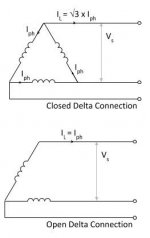wwhitney
Senior Member
- Location
- Berkeley, CA
- Occupation
- Retired
I haven't. : - )Wayne, I know you are not an electrician so maybe you havnt thought about it,
I guess I assumed it would be determined at the time of the service installation and labeled.but how do you think we can tell which phases make up the phantom winding (genuine question, not being snarky)?
You could apply a significant test load both A-B and separately B-C (I've been calling the high leg B). On an open delta, one of those will cause a voltage drop A-C, and one shouldn't. The one that causes the A-C voltage drop is across the phantom coil.
Cheers, Wayne


